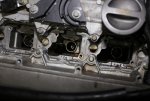Thanks for tip on CC - that's two things for me to check!
Have to disagree about the effect of opening a door. Your reasoning sounds sensible to me, but my Hydractive 2 document says otherwise:
"The door and boot open sensors will override the hard setting of the suspension as long as the vehicle
speed is below 24 km/h. The suspension will consequently go into soft mode whenever any door or the boot
is opened, and will remain in soft mode for 30 seconds after all the doors are closed if the vehicle speed
remains below 24 km/h. As long as the vehicle maintains a speed of at least 24km/h, normal rules apply,
and will continue to apply even if the doors remain open. It is important to note that the suspension will go
into soft mode even with the ignition switch turned off. Should the doors remain open with the ignition switch
in the off position, the suspension soft setting will be subjected to a 10 minute timeout to avoid draining the
battery, as the soft setting requires the electric valves to be energized."
You'll be pleased to know that I did not exceed 24km/h while doing the "door open" test.
This comes from a PDF that appears to be part of a larger document. The heading is "Hydractive 2 suspension system". I think John (JBN) might have sent it to me. I am assuming that Hydractive 2 is the same for an XM as for a Xantia.
Still haven't taken to for a drive to see whether hard mode will unlock once on the road - rain today, so she (?- not sure - might be male) stayed inside, warm & dry.
Cheers
Alec
Have to disagree about the effect of opening a door. Your reasoning sounds sensible to me, but my Hydractive 2 document says otherwise:
"The door and boot open sensors will override the hard setting of the suspension as long as the vehicle
speed is below 24 km/h. The suspension will consequently go into soft mode whenever any door or the boot
is opened, and will remain in soft mode for 30 seconds after all the doors are closed if the vehicle speed
remains below 24 km/h. As long as the vehicle maintains a speed of at least 24km/h, normal rules apply,
and will continue to apply even if the doors remain open. It is important to note that the suspension will go
into soft mode even with the ignition switch turned off. Should the doors remain open with the ignition switch
in the off position, the suspension soft setting will be subjected to a 10 minute timeout to avoid draining the
battery, as the soft setting requires the electric valves to be energized."
You'll be pleased to know that I did not exceed 24km/h while doing the "door open" test.
This comes from a PDF that appears to be part of a larger document. The heading is "Hydractive 2 suspension system". I think John (JBN) might have sent it to me. I am assuming that Hydractive 2 is the same for an XM as for a Xantia.
Still haven't taken to for a drive to see whether hard mode will unlock once on the road - rain today, so she (?- not sure - might be male) stayed inside, warm & dry.
Cheers
Alec

